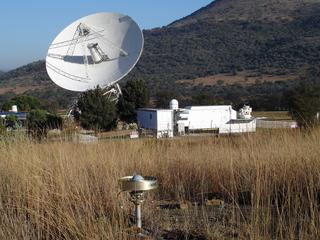About Us
Space Geodesy is one of the programmes of the Hartebeesthoek Radio Astronomy Observatory
Translations: Slovenian
What is HartRAO
Hartebeeshoek Radio Astronomy Observatory (HartRAO), situated just north of Johannesburg, currently has three main divisions: radio astronomy, space geodesy and science awareness. The space geodesy programme was a progeny of radio astronomy, as there is much synergy between geodetic Very Long Baseline Interferometry (VLBI) and radio astronomy techniques. The Space Geodesy Programme developed considerably during the last few years. With the addition of Satellite Laser Ranging (SLR) and Global Positioning System (GPS) to HartRAO, the facility has become one of only five fiducial geodetic sites in the world.
The complete profile of HartRAO is that of an international facility, rather than just a national facility. Its strategic location, ability to deliver, dedicated staff and strong leadership has made it a facility which is recognised internationally. Most of HartRAO's projects are therefore large international projects which allow local scientists to have access to global science and create the avenues towards new developments, capacity building and local expertise. Projects operate within the standards and guidelines of internationally recognised bodies, such as the International Association of Geodesy (IAG), International Astronomical Union (IAU) and their related services and commissions.
Our latest Broad-Based Black Economic Empowerment (B-BBEE) certification can be found here.
|
Figure 1. This picture of HartRAO show three of the main Geodetic system used: (a) Radio Observatory (the dish on the left), (b) SLR (just right of the Radio Observatory), and (c) GPS receiver (in the foreground). |
The Future of Geodesy and HartRAO
The scenery of space geodesy is changing as the need has been identified to improve the geometrical distribution of fundamental stations and to improve the accuracy and sampling rates of instrumentation. The location of space geodesy equipment at HartRAO is partially a spin-off from the NASA deep space tracking programme, the consequent CSIR establishment of radio astronomy utilising the tracking antenna, and the efforts from the space geodesy programme to collocate GPS and SLR with the telescope. The site was never "selected" as such in terms of scientific requirements based on astronomical seeing and cloud coverage criteria, so it is not optimally located for scientific output.
The future of space geodesy globally, is in the process of development and installation of dedicated geodetic VLBI antennas, (VLBI2010 project), KHz satellite laser ranging (SLR2000), denser GPS networks (AFREF) and the dissemination of data in near real-time. This concept is termed GGOS, an acronym for Global Geodetic Observing System, which is the first and only project of the newly restructured International Association of Geodesy (IAG). This system will continue to maintain the International Celestial Reference Frame (ICRF) and will provide necessary parameters such as Earth Orientation Parameters (nutation, precession, time etc.) to the global scientific community, astronomy of course being a major user of this product.
Basically GGOS views the Earth system holistically by including the solid Earth, the fluid components and static and time-varying gravity field in its products. This concept combines different techniques, models, and approaches in order to achieve a better understanding of geodetic, geophysical and geodynamical processes. GGOS will provide the scientific and infrastructural basis for all geodetic global change research. This IAG Project commenced with the definition phase in 2003 and is based on the IAG Services.
VLBI 2010 will operate at S, X and Ka bands. The present HartRAO telescope cannot operate efficiently at Ka band (32 GHz). VLBI2010 requires dedicated, 24 hour geodetic measurements monitoring earth rotation to find sub-diurnal rotational variations on the micro-arcsecond level as well as dedicated equipment to monitor Total Electron Content of the ionosphere, maintenance and expansion of the ICRF etc. Currently only 15 % of the HartRAO telescope is allocated to space geodesy which is a fraction of what is required.
Air pollution, proximity of large cities and industrial areas impose severe restrictions on HartRAO as a facility to expand and improve its activities in Satellite Laser Ranging and Lunar Laser Ranging.
What is the Matjiesfontein Outstation?
Given all the problems and restrictions imposed on HartRAO as stated above, it is essential to relocate all the Geodesy related work from HartRAO to a new location. The Matjiesfontein Outstation is the proposed new Space Geodesy site. This site will host all four aspects of Space Geodesy:
- Very Long Baseline Interferometry (VLBI)
- Global Positioning Service (GPS)
- Satellite Laser Ranging (SLR)
- DORIS
The SLR will also be enhanced to do Lunar Laser Ranging (LLR), which means that South Africa will be the only country in the southern hemisphere to do LLR. Three diferent sites in South Africa are being looked at as possible locations for this Outstation:
- A site in Lesotho that is 3000m up in the mountains.
- Sutherland
- Matjiesfontein

